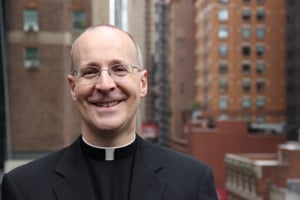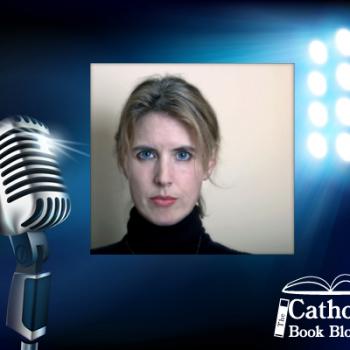 PETE: Your new book Jesus: A Pilgrimage for lack of better words is massive. How much time went into writing this book?
PETE: Your new book Jesus: A Pilgrimage for lack of better words is massive. How much time went into writing this book?
FATHER JAMES MARTIN: In a sense, I’ve been working on it for 25 years—ever since I entered the Jesuit novitiate in 1988. It was then that I started to study and pray about Jesus in earnest. But the book itself took me about five years from start to finish. But every day I worked on it was a joy—truly!
PETE: What research is required for a work of this magnitude?
FATHER JAMES MARTIN: There were different types of research. The most challenging was the work of reviewing all the contemporary New Testament scholarship so that I would be able to present the current thinking on a variety of Scripture passages. But that was one of the most enjoyable parts of the book. There are so many wonderful Bible commentaries, with absolutely fascinating insights, that never get read by the general public because they’re written in a very “academic” style. So I wanted to make the best Bible scholarship accessible to a general audience with this book.
Second, there was the research that I undertook on my pilgrimage to the Holy Land in 2011. At first, I didn’t really want to go to Israel, since I worried that seeing “touristy” sites might ruin my pristine mental images of places like Nazareth, Bethlehem and the Sea of Galilee. But as anyone who has journeyed there knows, simply being there was immensely helpful in understanding the Gospels. Knowing the topography made the Gospels come alive in ways that I couldn’t have imagined. I share a lot of those insights in this book. This is why the Holy Land is often called “The Fifth Gospel.”
Finally, there were years of prayer that were brought to bear on this book. I combed through my retreat journals to locate insights related to various Bible passages, which I share liberally in the book.
And then of course there was the construction of the book, the writing, the editing, the footnotes–and then the editing and editing and more editing. On top of that was the work of other people. I sent the book out, for example, to dozens of New Testament scholars for their feedback, which was astoundingly helpful. And of course there were editors at my publisher, fact checkers and even an independent copy editor who I found, who was a huge help. It was a big project.
PETE: I think your book is approachable on many levels. Who was your intended target audience?
FATHER JAMES MARTIN: Don’t laugh: Everybody. I wanted Jesus: A Pilgrimage to be accessible to everyone from the person who knows very little about New Testament scholarship to the person who has devoted their whole life to Jesus. Consequently, I start with the basics—explaining how the Gospels were constructed, what we mean about Jesus being human and divine, and even talking about how a little Greek helps us better understand the texts. But I also assume that people can come up to speed quickly and, as Jesus said, “follow me.”
PETE: If there is one thing you want readers to take away from this what would that be?
FATHER JAMES MARTIN: That it is important to understand both the “Jesus of history” and the “Christ of faith.”
Most books focus on one or the other—to the exclusion of the other. In other words, books on the historical Jesus, that is, on what history and archeology can tell us about the life and times of Jesus of Nazareth often say, “Well, we won’t talk about the miracles or the Resurrection because those are faith-based questions.” And religious books on Jesus, which focus on his divine identity and highlight his miracles, often say, “Well, we won’t treat ‘mere historical questions.’”
But you need to know about both approaches. You simply cannot understand one without the other. How can you fathom his parables, for example, if you’ve no clue what first-century Palestine was like? His real-life example will make no sense. So you have to know the history. And how can you ignore the miracles when they are a huge part of the Gospels? In fact, if you omit the miracles some of Jesus’s sayings that people take for granted are left with no context. So this book brings both the Jesus of history and the Christ of faith together—they are one.
PETE: Honest answer required on this one. This book has received a lot of pre-release buzz. Does that make you nervous that the anticipation level is set so high?
FATHER JAMES MARTIN: Honestly, not really. I’m delighted that the advance reviews and endorsements have been so positive and that the pre-orders are high, but I try to focus on what the book might mean for the individual reader—rather than how many copies we sell. Of course my Wharton background helps me to remember that in order to have people read the book, I have to promote it—and I’ve been working hard on that. But the more “nervous” part was working on the book, that is, making sure I got everything right in the writing.
PETE: Do you have any other projects in the works you can share with us or after this project are you taking a well-deserved break?
FATHER JAMES MARTIN: Well, I won’t have that break, well deserved or otherwise, for some time, since I’m promoting my book for a few months. But I will take a break from book writing (not from writing for venues like America of course, since that’s my job). Then I’ll turn my attention to a book on prayer.
PETE: Time for my signature ending question. This is a blog about books. What is currently on your bookshelf to read?
FATHER JAMES MARTIN: I always have a few books on my nightstand: To End all Wars, by Adam Hochschild, a book about resistance movements in the First World War, No Irrelevant Jesus, a book of essays by the New Testament scholar Gerhard Lohfink, and Mercy, by Cardinal Walter Kasper on, of course, mercy. Plus, I’m rereading one of my favorite Bill Bryson books, I’m a Stranger Here Myself.











